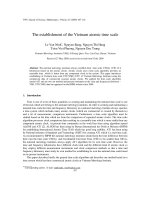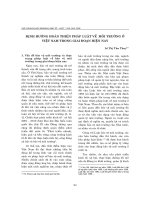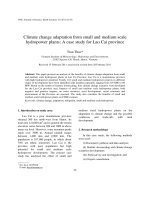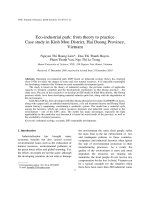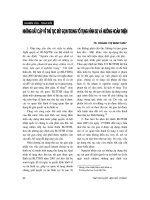Tài liệu Báo cáo " Climate change adaptation from small and medium scale hydropower plants: A case study for Lao Cai province " doc
Bạn đang xem bản rút gọn của tài liệu. Xem và tải ngay bản đầy đủ của tài liệu tại đây (55.67 KB, 9 trang )
VNU Journal of Science, Earth Sciences 27 (2011) 32-38
32
Climate change adaptation from small and medium scale
hydropower plants: A case study for Lao Cai province
Tran Thuc*
Vietnam Institute of Meteorology, Hydrology and Environment,
23/62 Nguyen Chi Thanh, Hanoi, Vietnam
Received 15 February 2011; received in revised form 28 February 2011
Abstract. This paper presents an analysis of the benefits of climate change adaptation from small
and medium scale hydropower plants in Lao Cai Province. Lao Cai is a mountainous province
with high hydropower potential. Totally 116 small and medium hydropower projects in different
stages of development have been identified with installed capacities ranging from 0.9 MW to 60
MW. Based on the results of statistic downscaling, four climate change scenarios were developed
for the Lao Cai province area. Impacts of small and medium scale hydropower plants, both
negative and positive impacts, on water resources, rural development, social economic and
environment of the Province are assessed. The study also considers the benefits of small and
medium scale hydropower plants on CDM revenues.
Keywords: climate change, adaptation, mitigation, small and medium scale hydropower.
1. Introduction on study area
∗
Lao Cai is a poor mountainous province
situated 300 km north-west from Hanoi. Its
total area is 8,060 km
2
and in general the terrain
elevation varies between 300 and 1000 m above
mean sea level. However, some mountain peaks
reach over 3000 m. Annual rainfall ranges
between 1,400 mm and 2,900 mm. The
population is 557,000 people, in which about
70% are ethnic minorities. Lao Cai is the
province with poor population but high
potential for small and medium scale
hydropower development. The present case
study has analyzed the effect of small and
_______
∗
Tel.: 84-4-38359540
E-mail:
medium sized hydropower plants on the
adaptation to climate change and the possible
symbioses and trade-offs with rural
development.
2. Research methodology
In this case study, the following methods
were used:
(i) Document synthesis and data analysis;
(ii) Statistic downscaling and climate change
scenarios development;
(iii) Field survey and investigation; and
(iv) Expert consultation.
T. Thuc / VNU Journal of Science, Earth Sciences 27 (2011) 32-38
33
3. Results and discussion
3.1. Climate change in Lao Cai
Four different scenarios, as simulated by
around 40 different Global Circulation Models
and Atmospheric-Ocean Global Circulation
Models, are used to assess climate change
impacts in Lao Cai Province, namely: Baseline
scenario using the historical data and simulating
the climate during the period 1961-1990, low
emission Scenario B1, medium emission
scenario B2, and high emission Scenario A1FI.
The results have been downscaled to give
plausible results for the Lao Cai Province [1].
From the scenarios, it is seen that there is an
increase in temperatures during the 21
st
century
in Lao Cai Province. Mean annual temperature
would increase about 1.3 to 1.7
o
C by 2050, and
2.1
o
C to 4.2
o
C by 2100. Temperature rise is
expected to be lowest in July (1.8
o
C to 3.5
o
C)
and highest for the period November - March
(2.2
o
C to 4.5
o
C). Annual rainfall also increases
gradually over the 21
st
century, i.e. 15-17%, and
21-41% higher than the average value of the
baseline period (1961-1990) by the year 2050
and 2100, respectively. Flood peaks and flood
volumes with a given frequency would rise by
3-4% and 1-4%, by 2030, and 16% and 14% by
2100, respectively (Table 1).
Table 1. Changes in future flooding pattern
Estimated
Flood Increases
Estimated
Increase
by 2030
Estimated
Increase
by 2100
Peak Flows 3-4% 16%
Flood Volume 1-4% 14%
3.2. Small and medium hydropowers system in
Lao Cai
Totally 116 small and medium hydropower
projects in different stages of development have
been identified in Lao Cai Province, with
installed capacities ranging from 0.9 MW to 60
MW. Among them, there are 3 projects having
reservoir storages and only with regulation
coefficients of 3.1%, 6.5% and 9.7%,
respectively. The main part of the projects
(78%) has an installed capacity of less than 10
MW while the average installed capacity for all
116 projects is 7.8 MW. The hydropower
resources are not evenly distributed in the river
basins in the Province with the main potential
being in Ngoi Nhu River Basin with 37
identified small and medium hydropower
projects.
Simple economic evaluations show that if
the value of energy would be 5 UScent/KWh,
all 116 identified projects but one would be
economic viable, not an unrealistic assumption
with current prices for fossil fuel.
The estimated demand in Lao Cai Province
in 2010 and 2015 are 663.5 GWh and 1,357
GWh, respectively, the peak demand for the
same years are 146 MW and 271 MW,
respectively. Assuming that all projects under
construction and in an advanced stage of design
would be commissioned by 2010 and that all
projects being registered would be
commissioned in 2015, the projects can cover
the energy demand in 2015 for all months apart
from February and March (with a maximum
deficit of 5.9 GWh in March). The peak power
demand cannot be covered by the identified
small and medium hydropower projects for
December to April in 2015, and the maximum
deficiency amounts to 125 MW in 2015. The
energy and peak power deficits need to be
imported from outside of the province, while
surplus energy may be exported with a total of
at least 1.8 TWh/year in 2015 [2].
T. Thuc / VNU Journal of Science, Earth Sciences 27 (2011) 32-38
34
3.3. Impacts of small and medium hydropowers
system to natural resources, environment and
social economics rural development
3.3.1. Impacts to natural resources, environment
a) Environmental aspects
An overall assessment of potential
environmental impacts is conducted for three
representative basins, including 17 hydropower
projects. Construction of hydropower will
affect the terrestrial ecosystems at the project
sites and the surrounding areas. Most of the
ecosystems at the project sites are very poor
with scattered vegetation cover.
The identified projects are designed to
release water from the reservoir to downstream
power house, and in some cases, to a nearby
river basin, implying that unless compensation
flow releases from the dams are enforced, river
reach between the dam and the power house is
dry or almost dry during the dry season. For the
17 investigated projects in Ngoi Bo, Ngoi Xan
and Suoi Chut rivers, the potentially dry river
reaches are amount to 48.5Km. It seems that the
given energy production of the identified
projects do not include environmental flow to
mitigate impacts on the downstream aquatic
ecosystem, biodiversity and human activities. If
environmental flow, defined as the 90%
probable average flow during the three driest
months every year, is adopted, the reduction in
energy production for the identified projects is
estimated at nearly 10%. This reduction will
have consequences on the economic viability of
the projects and only 80 (69%) of the identified
projects, with a total installed capacity of 721.3
MW (80%) and an average annual energy
production of 2,816 GWh (72%), would in that
case be economically viable [3].
b) Water allocation and conflicting demands
The conflicting demands from various
water users in the three focus basins are
scrutinized and modeled. The simulation results
show that it would be possible to meet
downstream water demands and of the
environment by releasing a certain amount of
flow to the river. The implications for the
power production of such compensational flows
is as stated above.
3.3.2. Effects of hydropower projects on
climate change adaptation and mitigation
Effects of hydropower projects on climate
change adaptation and mitigation can be
summarized as follows: (1) Climate change
mitigation related to reduction of greenhouse
gas (GHG) emissions by replacing thermal
power production; Climate change adaptation
related to changes of the hydrological pattern
with increased floods, such as increased
occurrences of flash-floods, that may be
alleviated by storage capacities of reservoirs;
(3) Climate change adaptation related to
changes of the hydrological pattern with more
pronounced dry periods that may be alleviated
by release of water stored in hydropower
reservoirs during dry periods giving positive
effects on downstream water supply and
irrigation.
a) Mitigation effects
Regarding climate change mitigation, two
alternatives are investigated as follows:
Alternative 1: Assuming that power
produced by the plants will alternatively have to
be generated from coal fired plants, a yearly
GHG emission of 4.28 million tons may be
avoided by implementing all the 116 identified
small and medium hydropower projects in Lao
T. Thuc / VNU Journal of Science, Earth Sciences 27 (2011) 32-38
35
Cai Province assuming no environmental flow,
compared to 3.12 million tons/year if
environmental flow is adopted on the remaining
80 economic viable projects, i.e. a difference of
1.16 million tons/year. Hence, there is a trade-
off to be considered between producing more
climate neutral energy and conservation of the
local environment. GHG emission from the
reservoirs represents only some 0.2% of the
avoided greenhouse gas emission from the coal-
fired thermal plants, and can therefore be
neglected.
Table 2. Yearly Avoided GHG Emission for Different Development Scenarios.
Scenarios Outline
Number
of Projects
Total
Installed Capacity
MW
Total
Energy
GWh/year
Total Avoided
GHG Emission
Million Tons/year
1
Existing + projects under
construction
26 396.8 1,662.1 1.78
2
Scenario 1 + projects in
advanced design stage
43 551.3 2,290.4 2.46
3
Scenario 2 + registered
projects
61 738.6 3,134.2 3.36
4
Scenario 3 + non-committed
projects
121 928.6 3,990.5 4.28
Alternative 2: This alternative considers
only economically and financially viable
projects with and without CDM funding and
using a baseline emission factor of 588 tons
CO2/GWh (average for the Vietnamese grid).
In this alternative, a yearly GHG emission of
3.45 million tons may be avoided by
implementing all the 85 financially viable (with
CDM revenues) hydropower projects,
compared to 2.24 million tons by implementing
the 45 financially viable (without CDM
revenues) projects, i.e. a difference of 1.21
million tons/year. If all 30 projects, i.e.
excluding existing and projects under
construction, that become financially viable due
to carbon credits are implemented an additional
yearly GHG emission of 1.0 million tons may
be avoided.
Table 3. Yearly Avoided GHG Emission for Different Development Scenarios
of Financially Viable Projects with CDM Revenues.
Scenarios
Outline
Number
of
projects
Total installed
capacity
(MW)
Total
energy
(GWh/year)
Total avoided
GHG emission
(Million
Tons/year)
1
Existing + projects under
construction
23 380.0 1,598.2 1.71
2
Scenario 1 + projects in advanced
design stage
33 464.2 1,935.2 2.08
3
Scenario 2 + registered
projects
48 600.6 2,578.4 2.77
4
Scenario 3 + non-committed
projects
85 739.2 3,219.1 3.45
T. Thuc / VNU Journal of Science, Earth Sciences 27 (2011) 32-38
36
b) Adaptation effects
Low flow augmentation: It is seen that only
one plant in the Province (Seo Mi Ty) has
sufficient storage to augment low flows. This
effect is localised, at the first downstream
confluence with the larger Ngoi Bo River the
effect is negligible. Another plant under
construction in the Province has a larger
regulating effect, but since this is classified as
large hydropower plant. The planned small and
medium sized plants in the Province will
consequently not have any low flow
augmenting effects.
Flood alleviation effects: Due to lack of
active storage capacity, none of the planned
small and medium hydropower projects in the
Province have flood alleviating effects. The
physical effect of the considered plants on
climate change adaptation by flood alleviating
is therefore negligible.
Estimated production under future climate
condition
If environmental flow to be provided,
average increase in energy production relative
to the present hydrological conditions is larger,
and it is estimated at 7.7% for 2030 and 12.1%
for 2050 for Scenario B1, 6.3% for 2030 and
10.1% for 2050 for Scenario B2, and 6.2% for
2030 and 13.5% for 2050 for Scenario A1. The
corresponding additional yearly avoided GHG
emission due to climate change is estimated at
some 200,000 and 400,000 tons for 2030 and
2050, respectively, by implementing all the 85
small and medium hydropower projects being
economically viable with environmental flow.
3.3.3. Rural development aspects [4]
Impact assessment is carried out following
the guidelines of OECD an ‘Ex Ante Poverty
Impact Assessment’. The method is applied to
summarise the process by which the
intervention is expected to influence
stakeholders (targeted and others), and to assess
the overall result anticipated by each of the
main transmission channels which are: prices,
employment, transfers, access, authority and
assets.
Important aspects of the potential positive
or negative effects on rural development are
future government policies on subsidies for
electricity, both connection fees and per KWh.
Likewise, the development of the electricity
market, and whether EVN’s monopoly will be
changed to an open market with possibilities for
local hydropower plants to set their own tariffs
for local networks, will to large degree
determine the effects of the hydropower plants
on rural development.
a) Impact on economic capabilities
Assuming a water resource tax rate of 2% at
a fixed rate of 700 VND/kWh, the developers
of the 58 plants shall pay about 29,4 billion
VND of water tax. It cannot be estimated how
much of these taxes will benefit Lao Cai
Province directly.
In the short term, during construction,
contractors will buy various construction
materials and businesses/trade households are
likely to benefit from hydropower development.
In some of the projects already under
construction a substantial number of local
workers have been hired for salaries
substantially higher than the average wages in
the area. Many workers are recruited in the
construction stage but only a few when they
come into operation.
T. Thuc / VNU Journal of Science, Earth Sciences 27 (2011) 32-38
37
On the negative side local farmers
upstream, near the construction sites and near
roads to the hydropower plants can be losing
because of land loss, degradation of natural
resources, and impacts on water and air
environment. Although they receive
compensation, recovery of their economic
production will take time. Fishing farmers can
lose income from fishing along rivers as
consequence of pollution during the
construction phase and flow diversion during
the operation phase, and due to blocked fish
migration.
In the medium term, most stakeholders can
get benefits from hydropower development
because of continuously supplying services to
the operation of the hydropower plants and
workers. Local farmers can have more
opportunities to develop their economy
provided they get access to reliable and
affordable electricity. However, farmers living
along the part of river between the dam and the
power house will likely be deprived of fishing
in the river, and can experience lack or shortage
of water for electricity generation by micro-
generators.
b) Impact on human capabilities
In the short term, local workers can have a
chance to improve their knowledge/skills for
future work; while local farmers living between
the dam and power station, and households near
the road to the hydropower development can
suffer a reduction in food security and in
nutrition sources because of reduction of rice
and fish productivity.
In the medium term, most stakeholders will
have better access by road, and thereby to
information and public services (medicine,
education, etc.), so their human capability can
be improved. Local farmers living between the
dam and power station will likely continue to
be negatively impacted.
c) Impact on political capabilities
Generally, local farmers are involved in
community consultations on issues related to
their life and assets in the design phase. They
also actively participate in negotiations on
compensation of assets, farming production,
etc. Thus, their political capability could be
improved in the short and medium term
allowing them to participate more actively on
public issues.
d) Impact on socio-cultural capabilities
In the short term, many outsiders will come
to the region and new relationships between
them and local people will be established. The
presence of outsiders will cause socio-cultural
disturbances among ethnic minorities and may
introduce or exacerbate some diseases.
However, in the medium term, those effects are
likely to disappear and no serious impacts are
expected on this dimension.
e) Impact on protective-security capabilities
In the short term the vulnerability of local
people seems to be increased because food
security for some households through fishing
and collecting aquatic organisms may be
reduced, or rice fields are lost or affected by
hydropower/road construction.
In the medium term, however, the economic
and human capabilities of most local people
could be improved as direct and indirect effects
of hydropower development. Their
vulnerability could be reduced and they can
easier withstand economic or natural shocks.
In the future, according to the analyzed
climate change scenarios, more rainfall is likely
T. Thuc / VNU Journal of Science, Earth Sciences 27 (2011) 32-38
38
to occur, implying that flash floods, rather than
droughts, may become a more serious problem
for the local people to deal with. However, flash
floods occur due to high rainfall, on near
saturated soil in steep terrain, and construction
of the hydropower plants are not likely to
protect against these factors.
Based on these assessments a scale of
positive and negative impacts in the short-term
and in the medium term has been applied.
4. Conclusions and recommendations
Recommendations can be drawn from the
study as follows: (1) Lao Cai is mountainous
provinces with high hydropower potential.
Totally 116 small and medium hydropower
projects in different stages of development have
been identified, with installed capacities
ranging from 0.9 MW to 60 MW; (2) yearly
GHG emission of 4.28 million tons may be
avoided by implementing all the 116 identified
small and medium hydropower projects in Lao
Cai Province assuming no environmental flow,
compared to 3.12 million tons/year if
environmental flow is adopted on the remaining
80 economic viable projects, i.e. a difference of
1.16 million tons/year. (3) Transparency, access
to information and proactive information
dissemination on both positive and negative
impacts of the projects from the investor and
the provincial and local authorities must be
ensured; (4) Adherence to the policy relating to
land clearance approved by the government and
the People’s Committee of Lao Cai Province to
minimize negative impacts on households
losing residential, agricultural, forest land etc.,
and to avoid conflicts between the project
investor and local people; (5) Ensure that
negative effects on the environment and
especially the aquatic environment are
mitigated as much as possible; (6) Use as much
as possible local labor resources for work in the
project; (7) Work force recruited from outside
should only be for technical, monitoring and
managing positions; (8) Register the residence
of workers and their families to help the local
authority to manage the work force and security
in the project area; (9) Educate the workers on
their duty not to encroach and discriminate
local customs, tradition and habits; (10)
Organize seminars on new policies and
regulations to help workers and local people
understanding this context, (11) Projects should
support local construction of health service
stations, schools, roads, water and electric
providing systems; (12) Use of standard quality
approaches to resettlement; and (12) Technical
training for local people to work in projects.
References
[1] R. L. Wilby and Christian, Using SDSM Version
3.1 - A decision support tools for the assessment
of regional climate change impacts, 2004.
[2] Vietnam Institute of Meteorology, Hydrology
and Environment, Final report of the project:
“Benefits on Climate Change Adaptation from
Small and Medium Scale Hydropower Plants:
Synergies and trade-offs with rural
development” Case study in Lao Cai province,
Hanoi, 2009.
[3] Vietnam Institute of Meteorology, Hydrology
and Environment, Technical report: Small and
medium hydropower as adaptation measure for
rural development in the context of climate
change, Hanoi, 2007.
[4] Vietnam Institute of Meteorology, Hydrology
and Environment, Technical report: Rural
development aspects on small and medium scale
hydropower, Hanoi, 2007.
T. Thuc / VNU Journal of Science, Earth Sciences 27 (2011) 32-38
36
